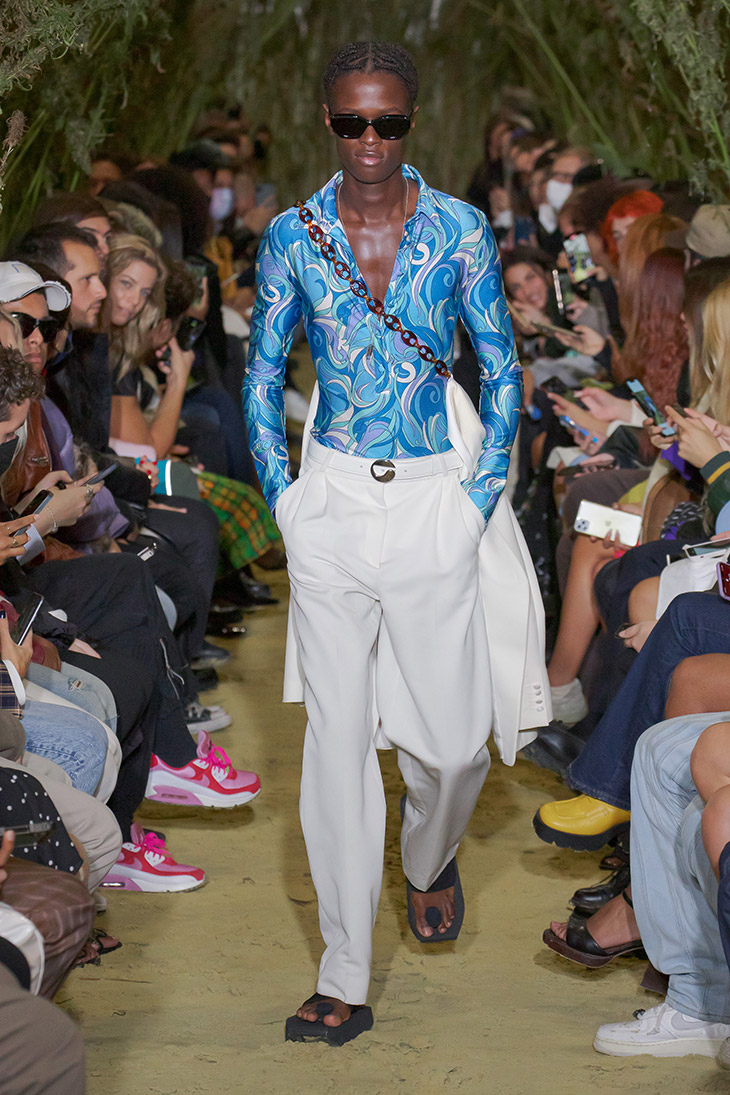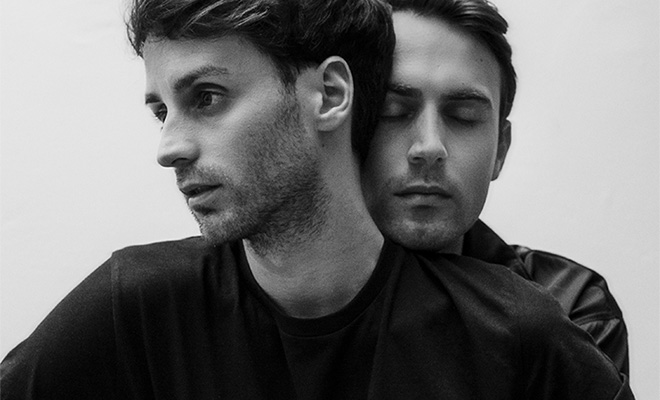
For DSCENE magazine‘s Issue 16, Sébastien Meyer and Arnaud Vaillant the founders of COPERNI sit down with Fashion Director Katarina Djoric to talk about the centre of Coperni universe, but also innovative silhouettes and the fashion industry’s obsession with overproducing.
You started Coperni in 2013 but put it on hold while you were Creative Directors of the historic French brand Courrèges. After ALMOST THREE years, you left the brand and relaunched Coperni in 2018. It looks like it wasn’t really hard for you to get back in touch with your old customers and gain a lot of attention from the new ones. It almost came naturally?
We were actually very surprised about the response of the press and buyers to the comeback of Coperni. They were thrilled to see the brand back. They all followed the evolution of the first Coperni, from our first collections to when we won the ANDAM prize. Courrèges was a great experience, but we needed to come back to Coperni. It was a chapter that was not finished.
Copernicus placed the Sun at the center of the Universe, and we wanted to place women at the center of ours. We want them to feel great in our clothes. It’s also a nod to innovation, to new technologies, which are at the center of our preoccupations as designers.
The name Coperni is inspired by a Renaissance astronomer Nicolaus Copernicus and his theory of Heliocentrism. Why? What is at the center of the Coperni universe?
Copernicus placed the Sun at the center of the Universe, and we wanted to place women at the center of ours. We want them to feel great in our clothes. It’s also a nod to innovation, to new technologies, which are at the center of our preoccupations as designers.

Heliocentrism was very controversial at the time. Do you think Coperni is also a bit ahead of its time?
We definitely have a futuristic vision and aesthetic. We love innovation and digital media, but we also love beautiful clothes that are wearable and well-made for modern people. We love this contrast. So, I would rather say that Coperni goes along with the times.
I’m especially thinking about your fashion shows. The catwalk hasn’t truly changed much since the 1960s. Why is it important to always specifically step out of the box?
We have always been passionate about digital media and technology. That’s why we constantly work on new projects. We like to play with digital tools. We did the first XR, extended reality, campaign. We always do adventures and games on Instagram, but the runway format is essential for showing our clothes and describing the Coperni woman, the silhouette. And it is vital to get this human aspect that is essential to our work, this special moment when models walk in an installation to specific music; when people all gather to show something at the same time.
But on top of that, we always want to create experiences. We don’t believe in the overly-classical catwalk format. We believe in creating new experiences and dreams.
There is something about an innovative feminine and sexy silhouette answering a common need for fun and lightness.
I really loved your FW21—it defined a new format.
Indeed, the FW21 drive-in show was incredible, with models walking in a theater full of cars, journalists, and people from the industry. We did the highest Parisian show on the Montparnasse Tower one season before. In a hemp field the season after, we invited people to a psychedelic beach for summer. It’s always about creating a magical moment.
How did you find your aesthetic when you were first creating your label, and how different is it today?
I wouldn’t say it’s different, but our collections have become richer. At first, it was a translation of the evolving technology and precision of new textiles into nonchalant shapes with a youthful attitude. Now, I think there is something about an innovative feminine and sexy silhouette answering a common need for fun and lightness. There are also more unisex pieces in our collections. The style of Coperni is always the same, with a lot of tailoring, evening dresses, and futuristic accessories. But it’s evolving season after season depending on how Sébastien, our creative director, feels about society and what women want.

In 3 years, you’ve designed an intelligent wardrobe that mixes minimalism with Parisian flair. Can you describe Coperni using these keywords?
Coperni executes a minimalist and technological wardrobe with artisanal fervor and Parisian flair that is wearable and desirable—always wearable. You can wear Coperni and go straight to your evening plans from the office. That’s important to us because it’s what people around us want to wear.
Your Swipe Bag, inspired by Apple’s airplane mode, is already gaining cult status. Did you expect that?
We are delighted and proud of the swipe bag. It was our first bag. I remember we were thinking about it, and then we had a revelation about the closing system. I don’t think we expected so much success, but I think it’s because of the aesthetic and semantic people know and feel close to. It’s evolving season after season, in different sizes and shapes, and we take a lot of pleasure in designing accessories.
The rise of vintage and second-hand is amazing, but the need for newness and creative pieces is essential.
We have recently seen a comeback of the ’90s in fashion. In your view, what should we take away from this era in fashion?
The Justin Timberlake gel haircut styling that we had when we were younger, lol.
What is new and exciting about today’s fashion world?
Digital, social networks, sustainability, new formats, new ideas. Those are all the challenges we are working on and are passionate about.
What do you think of the Instagram culture and the rise of influencers in fashion?
We think it’s amazing! There are many opportunists in this segment, but the ones we are working with and who are friends of the house, have this spontaneous, inclusive, and responsible vision of fashion that we admire. It’s not about hiring a hundred people and spending a lot of time and money on shooting or advertising. This girl next door has an immediate impact on the community and the final consumer. That’s fascinating.

We consume too much and produce too much; it’s a contradiction characteristic to fashion. How do you deal with that paradox?
I think people are playing badly with overproducing. Mainly from the mass market. Or producing quantities that will immediately go into sales or outlets. It’s kind of sad. We don’t feel a part of this. We produce very small series mainly in Italy and Portugal, just for our stockists’ orders, with a high sell-through rate, so we know that these pieces will be worn and not wasted. I think the rise of vintage and second-hand is amazing, but the need for newness and creative pieces is essential.
People are playing badly with overproducing. Mainly from the mass market. Or producing quantities that will immediately go into sales or outlets. It’s kind of sad. We don’t feel a part of this.
Do you think fashion and fashion designers can direct their consumers toward the necessary changes?
Absolutely, and that’s our responsibility! We have to lead them toward brands with strong values and ethical, inclusive creatives. We never copy. We always want to bring something new to our community, something they don’t already have in their wardrobe.

What is next for Coperni?
Many things! New collections, new collaborations, innovations, new bags. New fashion-show experiences. We can’t wait to unveil our next projects and keep developing this brand that we cherish every single day.
For more of Coperni log on to coperniparis.com

Interview published in DSCENE Issue 16 – get it now in print and digital.




















amazing interview